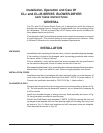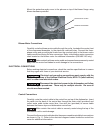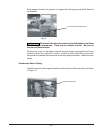
– 3 –
Installation, Operation and Care Of
CLe and CLeR-SERIES BLOWER-DRYER
SAVE THESE INSTRUCTIONS
GENERAL
The CLe and CLeR series Blower-Dryer unit is designed to assist the drying of
dishware by drawing room air through a heated plenum into the unloading end of
the dishwasher. The unit is powered by a 2 HP electric motor and is available with
three-phase electric service only.
A condensation tight, forced exhaust system to the outside is necessary for removal
of humid drying air. This exhaust system is to be supplied by the customer. Refer
to Exhaust Connections for recommended exhaust requirements.
INSTALLATION
UNPACKING
Immediately after unpacking the blower-dryer, check for possible shipping damage.
If the machine is found to be damaged, save the packaging material and contact
the carrier within 15 days of delivery.
Priortoinstallation,verifythattheelectricalserviceagreeswiththespecications
on the machine data plate, which is located on the rear of the unit.
After unpacking the blower-dryer, remove the items that were shipped loose (hardware,
blower motor, legs) from inside the unit. Remove shipping braces and discard.
INSTALLATION CODES
Installation must be in accordance with state and local codes, or in the absence of
local codes, with the National Electrical Code ANSI / NFPA 70 (latest edition). In
Canada, the installation standard is: CSA C22.2 No. 1 (latest edition).
CLeR MODELS ONLY
Remove the side panels from the energy recovery hood assembly as shown in Fig.
1A. The side panels may be discarded; however, do not discard the hardware as
it will be reused.
InstallnewchamberangestoenergyrecoveryhoodassemblyasshowninFig.
1A using hardware removed in previous step.
Position the CleR blower dryer template (F-38373, Fig 2A) by aligning the front and
top edges of the template with the front and top edges of the energy recovery hood
as shown in Fig. 1A. Mark hole locations and drill necessary holes per template.
Hole diameters are shown in Fig. 2A.


















